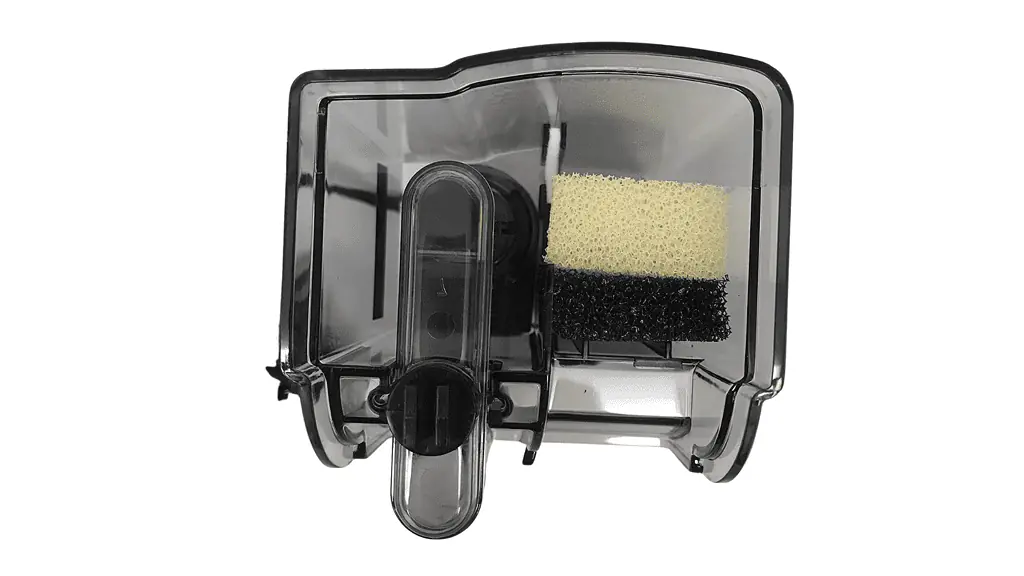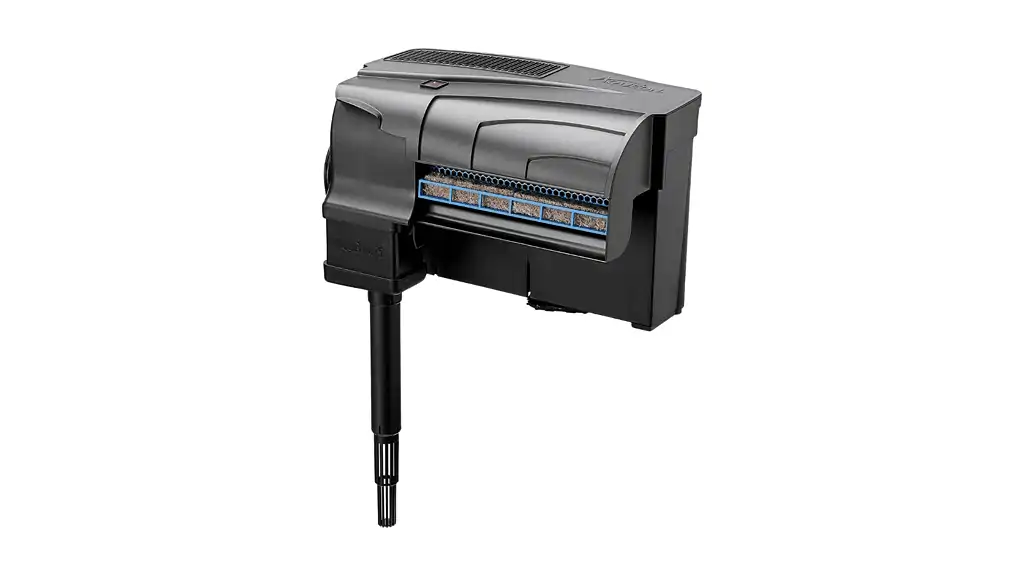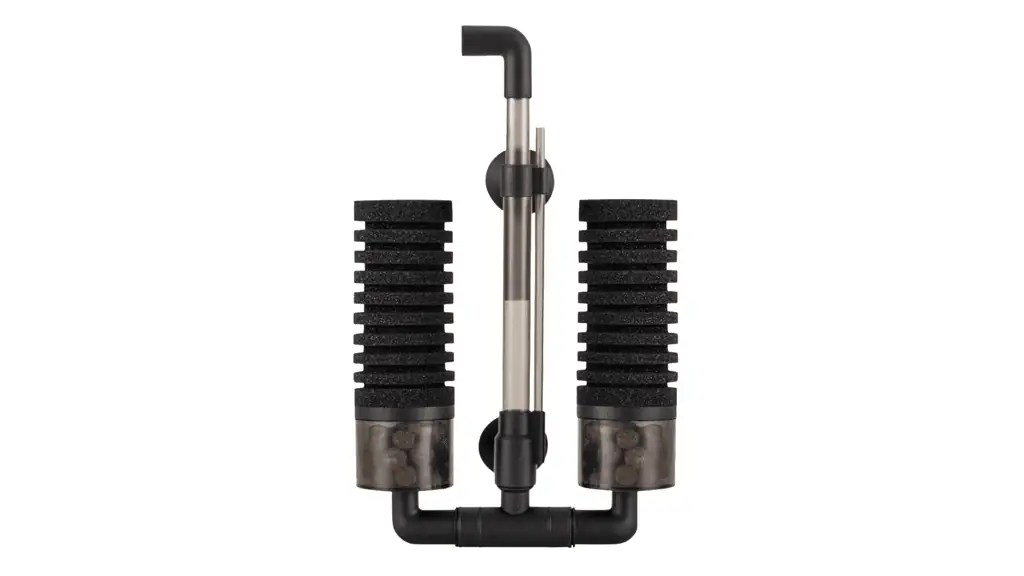Choosing an aquarium filter for a betta tank can seem overwhelming.
With so many features and sizes, knowing which one is right for your betta is challenging.
You must consider the filter’s flow rate and the size of your aquarium.
So, what is the best filter for bettas?
The Hygger Aquarium Double Sponge Filter is our top choice for the best betta filter. Its low flow rate and ease of use make it an excellent choice for beginner and experienced betta keepers.
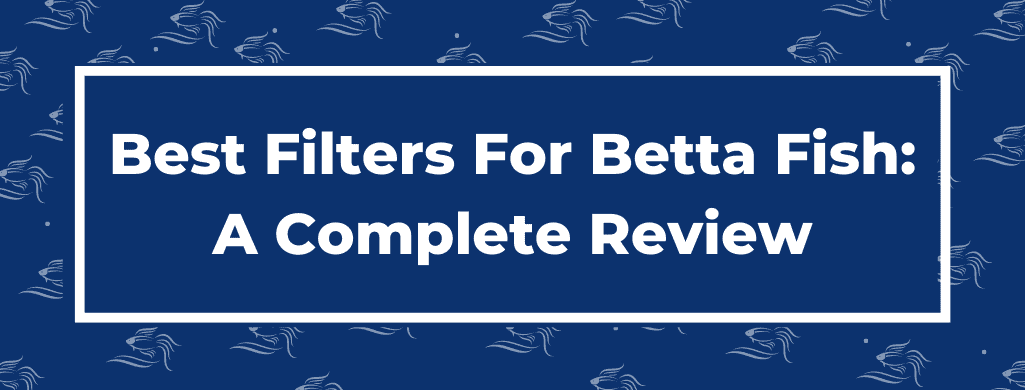
Our Top 4 Picks for the Best Filters for Bettas
- Tararium Mini Filter (Best Budget-Friendly Filter)
- AZOO Mignon Filter (Best Filter for Small Tanks)
- Aqueon QuietFlow Pro (Best Filter for Large Tanks)
- Hygger Aquarium Double Sponge Filter (Best Overall Filter)
4 Best Filters For Bettas Reviewed
Tararium Mini Filter
- Biochemical filter sponge
- Easy to clean
- Quiet operation
- Waterfall-style flow output
The Tararium 411B Mini Filter is our top pick for a budget-friendly betta filter option. Its low price and ease of use make this a great filter for beginners and experienced betta owners.
This filter features an adjustable flow rate for a gentle current in your betta tank.
Its compact design fits well in smaller betta tanks, and the strong suction cups keep it firmly in place.
Removing the sponge filter is easy, and the sponge does not need replacing. Simply rinse the sponge in tank water and place it back into the filter.
The adjustable output nozzle lets you change the output flow direction to reduce noise.
Filter Specifications:
- Type: Submersible
- Output: Up to 79 GPH
- Suitable Tank Size: 2-15 gallons
- Adjustable?: Yes
- Filter Media Included?: Includes one reusable filter sponge
AZOO Mignon Filter
- Automatic water recovery
- Durable water intake strainer
- Replaceable filter cartridge
- Transparent housing
The low flow rate and hang-on-back (HOB) design of this AZOO Mignon Filter makes it an excellent choice for smaller tanks.
Even though this filter is rated for tanks up to 4 gallons, it can work well for a 5-gallon tank.
Its adjustable flow rate ensures the currents are not too strong for a betta fish.
The water intake strainer keeps bettas and shrimp from getting pulled into the water flow. It also keeps large pieces of debris from clogging your filter.
An automatic water recovery feature lets the filter restart on its own after a power failure.
Since the filter hangs on the back of the tank, changing the filter media is easy.
Transparent housing lets you see the filter media so you know when it gets clogged.
The only downside to this filter is the low quality of the included filter media. But replacing the filter media with something better is easy.
Filter Specifications:
- Type: HOB (hang-on-back)
- Output: Up to 16 GPH
- Suitable Tank Size: 2-5 gallons
- Adjustable?: Yes
- Filter Media Included?: Includes 2 filter sponges plus 1 sponge for the water intake
Aqueon QuietFlow Pro
- LED cartridge change indicator
- Self-priming pump
- Supports a five-stage filtration process
- Quiet performance
We chose the Aqueon QuietFlow 75 LED Pro as the best filter for large tanks because it can filter tanks up to 90 gallons.
The Aqueon QuietFlow also comes in other sizes for 20, 30, 45, and 50-gallon tanks.
An LED light on the filter flashes when it is time to change the filter cartridge. This light triggers when water flow cannot pass through the filter due to a clog.
This quiet filter has an internal pump, and it reduces leaks through its self-priming feature.
Five-stage filtration removes debris and toxins, keeping the water crystal clear.
The patented Bio-Holster and Bio-Grid provide plenty of surface area for beneficial bacteria growth.
While the water output is a bit strong for betta fish, this filter features an adjustable flow system for slower currents. In a larger tank, the water output is less of an issue.
This filter is an excellent choice for larger community tanks due to its superb filtration system.
A common complaint with this filter is the cost of replacing the filter cartridges. This filter only takes Aqueon replacement filter cartridges and specialty cartridges.
These cartridges are more expensive than other filter media types.
- Type: Hang-on-back (HOB)
- Output: 400 GPH
- Suitable Tank Size: Up to 90 gallons
- Adjustable?: Yes
- Filter Media Included?: Includes 2 large filter cartridges and 1 specialty filter pad
Hygger Aquarium Double Sponge Filter
- Adjustable water outlet
- Two sponges
- Ceramic bio-media balls
- Easy to use
The Hygger Aquarium Double Sponge Filter is the best overall filter for a betta fish tank.
It produces a slow current and provides efficient filtration for optimal water conditions.
The submersible filter includes an adjustable output nozzle for better water flow control.
Placing the output nozzle below the water line oxygenates the water and reduces noise.
The included sponges have a fine texture of 60ppi (pores per inch), which provides more surface area for beneficial bacteria.
Ceramic media balls also encourage the establishment of beneficial bacteria.
This filter is easy to assemble and clean, and the strong suction cups prevent it from sliding down the tank walls.
You need a separate air pump with an output of 2.5 watts along with a 4mm air hose to use the filter. The air pump and hose are not included with the filter.
Hygger also offers a wide variety of other great aquarium products.
- Type: Submersible
- Output: Depends on the air pump wattage
- Suitable Tank Size: 10-40 gallons
- Adjustable?: Depends on the air pump
- Filter Media Included?: Includes 4 sponges and 1 bag of ceramic media balls
Do Bettas Really Need an Aquarium Filter?
Despite common belief, betta fish need an aquarium filter.
Aquarium filters maintain oxygen levels, circulate the water, and remove harmful bacteria.
Filters also provide a surface for beneficial bacteria growth. Beneficial bacteria break down toxic ammonia and nitrite into less harmful nitrates as part of the nitrogen cycle.
Fish waste, leftover food, and decaying plants produce harmful bacteria. An aquarium filter helps remove this harmful bacteria so your tank stays cleaner between partial water changes.
Some filter media also removes toxins like ammonia.
A filter maintains adequate water circulation in aquariums. This prevents stagnant water and ensures even heat distribution throughout the tank.
Aquarium filters help maintain a healthy environment for your betta.
Without a filter, your betta becomes more prone to illness from bacteria and poor water conditions.
What Features Do You Look For in a Betta Filter?
You must consider several factors when choosing an aquarium filter for your betta.
Flow Rate
Bettas cannot swim in strong currents because of their flowy fins and tails.
The fish also become stressed in fast-moving waters, and there is an increased risk of damage to their delicate fins.
If your betta swims in a curve instead of a straight line, the current is likely too strong.
You may also notice your betta avoiding the filter to avoid the current.
Look for an aquarium filter with an adjustable flow rate. This lets you lower the water flow and create a gentle current for your fish.
A sponge baffle placed at the output nozzle also decreases the water flow.
Cycling Ability
The cycling ability of an aquarium filter is measured in gallons per hour (GPH).
This measurement tells you how many gallons of water the filter can cycle in one hour.
An aquarium filter should circulate all the water in the tank 4-6 times per hour to keep your tank clean.
The following table shows the recommended GPH ratings of filters according to tank size.
| Tank Size | Filter Flow Rate |
|---|---|
| 5 gallons | 20-30 GPH |
| 10 gallons | 40-60 GPH |
| 20 gallons | 80-120 GPH |
| 30 gallons | 120-180 GPH |
| 40 gallons | 160-240 GPH |
| 50 gallons | 200-300 GPH |
| 75 gallons | 300-450 GPH |
| 100 gallons | 400-600 GPH |
Noise Level
A noisy aquarium filter can cause a lot of stress in your betta.
Noisy filters are also not ideal if your betta tank is in your living room or bedroom.
Choosing a quiet filter creates a more peaceful environment for your betta fish. Plus, it won’t keep you up at night.
No aquarium filter is completely quiet. But there are several ways of reducing the noise.
HOB filters are usually louder because of the water flow at the tank’s surface. Submersible filters are quieter, but their air pump makes a low humming sound.
Buzzing or Rattling
Loud buzzing or rattling noises indicate a problem with your aquarium filter.
A buzzing sound usually means not enough water is moving through the filter. Cleaning and replacing the filter media solves this issue.
Vibrations or rattling noises occur when part of the filter breaks. The sound gets louder as the damage increases.
Inspect your filter for broken parts and repair or replace it right away.
Loud Splashing
You may hear loud splashing noises when using a HOB or power filter. This splashing means the water levels in your betta tank are too low.
Ensuring your tank has enough water prevents these splashing sounds. Reducing your filter’s flow rate prevents splashing from becoming common.
Splashing is also common when your filter restarts after a power failure.
Bubbling
Bubbling sounds are common with sponge filters.
Reducing the size of the bubbles with an air stone lowers the noise they make.
An enclosed hood also muffles the sounds of the bubbles.
The Size of Your Betta Tank
The size of your betta tank determines what type of filter works best.
Sponge filters work best for smaller tanks because of their low water output.
Hang-on-back filters are suitable for small and medium aquariums and take up less space than submersible filters.
Power filters equipped with several types of filtration are a good choice for larger community tanks. These filters are more efficient in removing toxins and circulating the water in large tanks.
Are There Different Types of Filtration Methods?

There are three stages of filtration in fish tanks:
- Mechanical
- Biological
- Chemical
Some aquarium filtration systems combine methods to remove various bacteria and toxins.
Mechanical
Mechanical filtration removes physical debris from your tank. Dirt, fish waste, and other small particles get removed through this method.
This type of filtration does not remove bacteria or toxins. Mechanical filtration removes visible particles so your tank water does not get cloudy.
Filter media used for mechanical filtration usually consists of filter floss and coarse sponges.
You must clean or replace your mechanical filter media every 2-4 weeks. The replacement frequency depends on the size of your tank and filter.
Biological
Biological filtration relies on beneficial bacteria produced in the nitrogen cycle.
These beneficial bacteria help keep your tank clean by feeding on the toxins in biological material like leftover food and fish waste.
The bacteria convert harmful toxins like ammonia and nitrites into less harmful nitrates.
Live plants complete the cycle by feeding on nitrates and releasing oxygen into the water.
Porous ceramic balls provide a surface area for the growth of beneficial bacteria.
Beneficial bacteria also thrive in mechanical media like filter floss and sponges.
Almost every type of filter media contains beneficial bacteria. They can live on any flat surface in the tank, such as plant leaves and substrate.
Chemical
Chemical filtration uses a form of carbon for the removal of tannins, organic proteins, and sediment.
Carbon filters cannot remove harmful ammonia or nitrites from the water.
Activated carbon inserts can remove certain heavy metals like copper and manganese. These heavy metals are in some soluble medications used for treating a sick betta.
If you have live plants in your betta tank, avoid using carbon filter media.
Carbon can absorb aquarium plants’ nutrients, such as iron and calcium.
What Are the Different Kinds of Filters for Betta Fish?
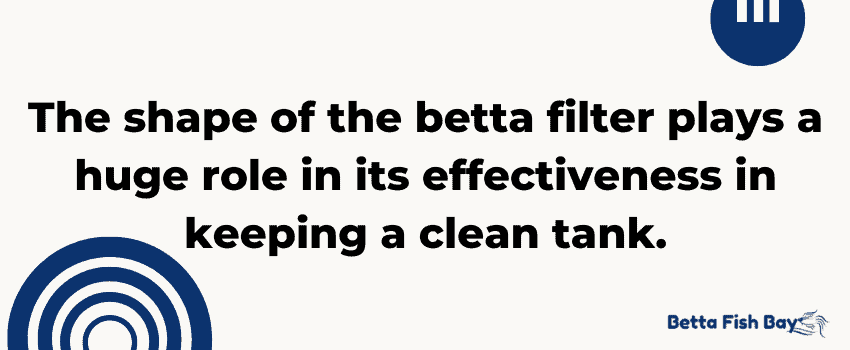
Filters have different variations in shape, size, and usage.
Some types of filters work better in betta tanks than others.
Ultimately, your choice of filter depends on your aquarium’s size and specific needs.
HOB Filter (Hang-On-Back)
Hang-on-back filters are nice because they do not take up a lot of space in your betta tank.
Since the housing for HOB filters sits outside of the tank, cleaning and changing the filter media is easy.
A tube attached to the filter goes into the tank. This tube pulls water into the filter media, which removes toxins as the water flows through it.
The filtered water then pours from an output nozzle back into the tank.
HOB filters are a bit noisier than other types of filters. Maintaining adequate water levels in your tank dampens the noise somewhat.
Some HOB filters produce too much of a water current for a betta tank.
An adjustable filter lets you slow the current to a more suitable level for your betta. A filter sponge also works well as a baffle at the output nozzle.
Internal Filter (Submersible)
Internal filters stay submerged in the water and usually attach to your tank with strong suction cups.
This type is one of the quietest aquarium filters out of all the other varieties. They also work well at keeping your aquarium clean.
Some internal power filters have an adjustable output nozzle. This allows you to change the output flow direction or extend it above the water.
Internal filters are more difficult to clean and replace the filter media without disturbing your tank. They also take up more space inside your betta tank.
Some internal filters have a compact design to go in smaller tanks.
Many internal filters have an adjustable flow rate and provide mechanical, biological, and chemical filtration.
Sponge Filter
Sponge filters are the most popular filter among betta fish owners because they are inexpensive and efficient.
Most sponge filters need a separate air pump to operate. Air pumps are also inexpensive and come in a range of power options.
You only need a 2.5-watt air pump for a 10-gallon tank. Larger tanks may need a 4-watt air pump.
Sponge filters can have one or two mechanical filter sponges for removing organic matter. Beneficial bacteria colonize the sponge and remove ammonia and other toxins from the water.
Some sponge filters have space for additional biological and chemical filter media.
A sponge filter is less powerful than other types of filters, so it works better in tanks under 40 gallons.
This type of filter is sometimes combined with an internal power filter in larger tanks.
Corner Filter
Corner filters, also known as box filters, were one of the earliest aquarium filters available.
These filters decreased in popularity once internal power and sponge filters flooded the market. But corner filters are still worth mentioning as they are sold in some fish stores and online.
A corner filter works in the same way as a sponge filter by using a separate air pump.
The filter is very small, so it fits in the corner of your tank. Box filters also have a low flow rate, which is perfect for a betta tank.
Corner filters consist of a clear box with slits on the side or top for the water intake. The box contains a combination of charcoal and aquarium filter floss for chemical and mechanical filtration.
Box filters are still popular with a select group of fish keepers. But, their rarity makes finding one a challenge.
Canister Filter
Canister filters are large and powerful, making them well-suited for tanks larger than 50 gallons.
These filters sit underneath the fish tank and use canisters filled with filter media for cleaning the aquarium water. A pressurized canister pumps the clean water back into the aquarium.
Canister filters are expensive and difficult to maintain. They are generally used by advanced fish owners with a lot of experience.
The powerful filter may also produce too strong of a current for your betta.
Under-Gravel Filter
Under gravel filters are another rare filter type, and for a good reason.
These filters sit underneath your gravel substrate and rely on it for mechanical filtration.
As a result, the filtration from an under-gravel filter is very inconsistent.
Some under-gravel filters have modules on the outflow tubing for attaching chemical filtration media.
Under gravel filters need a lot of work to maintain because they are difficult to clean.
This type of filter is not a good option for a betta tank, especially if you have live plants.
Breaking Down Our Choices for Best Betta Filters

Our top choice for the best filter for bettas is the Hygger Aquarium Double Sponge Filter because of its efficient filtration and ease of use.
This filter works well in smaller betta tanks due to its low water flow. It also provides plenty of space for encouraging the growth of beneficial bacteria.
If your betta is in a large community tank environment, the Aqueon QuietFlow Pro is an excellent choice.
Its large tank capacity provides efficient filtration through a five-stage process to clear your water crystal.
For a more budget-friendly option, the Tararium Mini Filter is a great choice. This filter is easy to set up and use and operates with very little noise.
Frequently Asked Questions About Aquarium Filters for Bettas
Are sponge filters better for bettas?
Sponge filters are well-suited for bettas, which is why they are popular among betta owners. These filters produce the slower flow bettas need and do not require a lot of extra maintenance.
Mechanical sponge filters are durable and inexpensive. This starkly contrasts the pricy replacement cartridges used in most internal power filters.
Sponge filters also provide reliable biological filtration, which prevents dangerous toxin build-up and keeps your betta healthy.
How powerful should the filter be for a betta fish tank?
An aquarium filter should be able to circulate all the water in your tank 4-6 times per hour. For example, a filter with a flow rating of 40-60 GPH works well in a 10-gallon tank.
We recommend sticking to the minimum flow rate for bettas. This ensures the current is not too strong for your fish.
How often should I clean the filter in my betta fish tank?
How often you clean your aquarium filter depends on several factors, such as:
– The size of your tank
– The size of your filter
– The number of live plants
– The number of fish in the tank
Following a weekly tank cleaning schedule and performing weekly water changes, your filter is less likely to get clogged. Check your filter media whenever you clean your betta tank to see if it needs cleaning or replacing.
Always rinse filter sponges and other biological media in tank water. Rinsing your filter media in tap water removes the beneficial bacteria and disrupts your nitrogen cycle.
Do I need to cycle my betta fish tank before adding a filter?
You must cycle your betta fish tank with a running filter to establish beneficial bacteria.
The beneficial bacteria needed for a nitrogen cycle colonize the filter media. Beneficial bacteria can live on any flat surface in your tank. But without a filter running, sustaining a beneficial bacteria colony is difficult.
How can I make sure the filter doesn’t harm my betta fish?
Prevent your filter from harming your betta by ensuring the current is slow. Your betta can struggle against strong currents and may become less active.
Slow the current by adjusting the flow rate or covering the output with mesh or a sponge.
The water intake current can sometimes pull on a betta’s delicate fins. If you have concerns about your betta swimming near the filter, cover the intake with mesh.
Watch your betta for signs of distress caused by the filter. Any time you notice your betta struggling to swim or getting pulled in by the filter intake, make adjustments right away.


